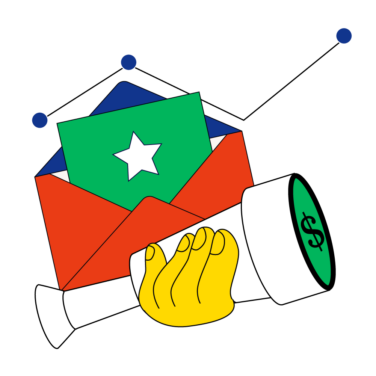The survival of your business depends on two things: reducing costs and increasing revenue.
Effective lead generation strategies do both — bringing in new sales at a lower customer acquisition cost. Here are 10 simple ways to grow efficiently.
What Is Lead Generation?
Lead generation is the process of attracting people to your business and getting them interested in your products or services — ultimately converting them into paying customers.
Generating sales leads is one of the most important things you can do. Here’s why:
- Your lead-generation efforts go hand in hand with your search engine optimization (SEO) efforts, increasing traffic to your website.
- Lead generation increases brand awareness by making your company more visible to potential customers.
- Nurturing leads builds trust among audience members, making it a little easier for your sales team to reach their goals.
- Once new leads enter your sales funnel, you can follow up by email. Even if a lead doesn’t buy from you, they can provide feedback that helps you improve your marketing strategy.
10 Ways to Get More Leads
Use these strategies to connect with your target audience and get them interested in what you have to offer.
1. Provide Ample Opportunities to Opt In
Don’t add one newsletter sign-up CTA to your website and call it a day, or you’ll have a tough time finding high-quality leads. Instead, give people ample opportunities to opt in.
Do: Every page of your site should have an opt-in form in the header, footer, or sidebar. If you do any email marketing (and you should), put a sign-up form at the bottom of each message in case one of your subscribers shares it.
Don't: Pop-ups can also be effective, but be careful not to overwhelm your readers. Never block important content or make it difficult to exit. You'll lose good leads with annoying pop-ups.
2. Make Landing Pages Actionable
You drove in leads via your website, social, or advertising — now what? Get them to take the next step (i.e. book a demo, download an ebook, etc.) with a clear call to action.
CTAs should be clear, actionable, and urgent. A/B test to see what resonates best with your audience.
Effective CTAs for lead generation
- Start your free trial
- Talk to an expert
- Claim this offer
- Download now
3. Simplify Your Lead Gen Form
If your lead gen form is overly complex, you run the risk of driving visitors away from your site instead of adding them to your sales funnel.
Only ask for the information your team needs to effectively follow up with the lead. This can include:
- Name
- Business
- Email and/or phone number
Other qualifying fields can be added, but ask yourself if you can find this information from lead intelligence platforms or other tools.
4. Write Irresistible Ad Copy
Copywriters are like magicians. Armed with nothing but a computer and a little creativity, they write ad copy that generates business leads and turns many of them into paying customers. Bring a little of that magic to your marketing strategy by writing irresistible ad copy for your PPC and social media campaigns.
Copywriting tips for lead generation
- Keep it concise. Show potential clients that you respect their time.
- Connect with audience members by using familiar terms.
- Insert relevant keywords.
- Write a clear CTA. See above.
- Tailor your tone of voice to audience demographics. B2B marketers may want to be a little more formal than marketers trying to connect with consumers, for example.
- Make your copy as enticing as possible.
5. Tempt Customers with Free Offers or Webinars
“If it’s free, it’s for me.” Use this adage to your advantage by offering a free e-book, case study, white paper, webinar, report, or software trial.
Just make sure that your freebie makes a great impression, or else you may drive away customers instead of enticing them to work with you.
6. Create a Rewards-Based Referral System
Existing customers are one of your most valuable assets. Turn customer loyalty into recurring revenue.
Referrals tend to sign on faster and churn less often than net new customers, greatly improving your LTV:CAC ratio.
Offer something of value in exchange for each referral. It could be something as simple as a free item or a discount on the customer’s next purchase.
7. Use Content Marketing to Educate and Engage
Your marketing strategy should include a mix of inbound and outbound marketing.
| Inbound lead generation | Outbound lead generation |
| Relies on organic growth channels like social media posts, search-optimized blog content and referrals from reviews. | Uses paid marketing campaigns like social media ads, Over-The-Top ads, Pay-Per-Click ads, and Local Service Ads |
| Higher quality leads because they show interest first. | Lower quality leads because you’re casting a wide net. |
| Harder to personalize for one person. Mostly segments. | Easier to personalize for one person. |
| Reaches a lesser but more tailored audience. | Reaches a large but less tailored audience. |
| Easier to measure the results | Harder to measure efforts |
| Cost less over a longer duration | Cost more over time |
| Less control over sales process | More control over sales process |
Content marketing is one of the most effective strategies for inbound marketing, positioning your company as an industry leader.
Outbound lead generation also differs a bit from prospecting. Check out this guide on prospecting vs lead generation for an easy overview.
Content Marketing examples
- Write in-depth blog posts to educate potential customers about your products.
- Publish articles on LinkedIn to help you connect with B2B leads.
- Create a podcast to inform listeners about changes in your industry.
- Develop a set of templates and offer them to your site visitors.
- Post educational videos on YouTube and other platforms.
- Offer free lead magnets, such as reports and e-books, in exchange for a user’s contact information.
8. Run Retargeting and Remarketing Campaigns
A good SaaS lead-generation campaign should include retargeting and remarketing.
Retargeting helps you connect with people who’ve never purchased from your company.
- Pixel-based retargeting involves placing a tracking pixel on a website to collect a user’s IP address and other information, giving you more insight into user behavior
- List-based gathers email addresses, phone numbers, and other contact information to send targeted advertisements to a user’s cell phone or email account.
Remarketing involves contacting inactive customers to get them interested in your brand again.
- Target users based on their intent, browsing activity, past purchases, or stage in the buyer’s journey
- Serve customized ads to members of your target audience when they search for specific keywords on Google
9. Target Competitor Customers with Gmail Ads
Gmail ads are one of the best lead-generation tools available, as they allow you to target your competitors’ customers.
For example, you can bid on branded keywords, ensuring that your company shows up when someone searches for a competing firm in your industry.
Google also allows you to target customers who browse specific websites, including sites owned by your main competitors.
10. Engage Customers with Live Chat
Offering live chat makes it easier for potential customers to get product and service information, increasing the likelihood that some of them will buy from you.
If you go this route, make sure that your live-chat feature makes the customer experience better instead of worse. Few things are more annoying than chatting with a bot who can’t answer your question or help you find the information you need.
Tips To Improve Lead Generation
The lead-generation process is dynamic, which means you need to tweak it regularly based on your user data. Follow these tips to ensure your process is as effective as possible.
Test, Test, Test
You should always be testing different versions of your ad copy and CTAs to see which ones produce the best results. It’s also helpful to test your email subject lines, as simple tweaks may double or even triple your current conversion rate.
Try Using AI and Automation
Artificial intelligence and marketing automation are extremely helpful for lead generation, as they’re capable of handling repetitive tasks that don’t require much human input.
While AI is working on low-level tasks, your sales pros can focus on doing product demos, following up with recent buyers, and performing other tasks that require more finesse.
Use the Right Tools to Manage Leads
If you don’t manage leads correctly, there’s a good chance a few leads will fall through the cracks, never to be heard from again.
Lead management software connects your sales, marketing, and customer success teams, ensuring that everyone is on the same page. Look for software that integrates with other tools and automates time-consuming activities.
Ramp Up Your Lead Generation
Lead generation doesn't need to be complicated. These 10 lead generation strategies include easy updates to your sales and marketing process that can result in big lead increases.
Ready to take your RevOps to the next level? Subscribe to The RevOps Team newsletter for expert advice, software reviews, and other resources to help you deliver predictable growth at scale.


